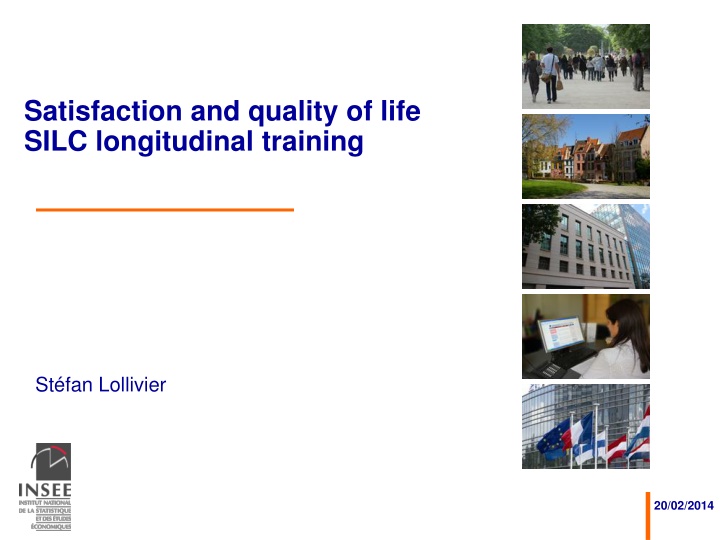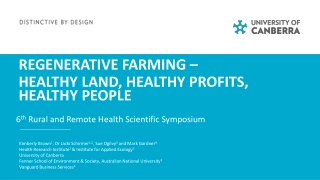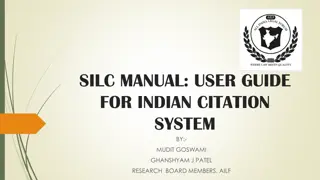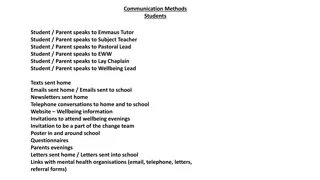
Quality of Life and Well-Being: SILC Longitudinal Training
Explore the multidimensional aspects of quality of life, including material living conditions, health, education, and more. Learn about the economic and political significance of well-being, as well as the FR-SILC two-year panel survey methodology. Discover how satisfaction and capabilities play key roles in assessing individual and societal welfare.
Download Presentation

Please find below an Image/Link to download the presentation.
The content on the website is provided AS IS for your information and personal use only. It may not be sold, licensed, or shared on other websites without obtaining consent from the author. If you encounter any issues during the download, it is possible that the publisher has removed the file from their server.
You are allowed to download the files provided on this website for personal or commercial use, subject to the condition that they are used lawfully. All files are the property of their respective owners.
The content on the website is provided AS IS for your information and personal use only. It may not be sold, licensed, or shared on other websites without obtaining consent from the author.
E N D
Presentation Transcript
Satisfaction and quality of life SILC longitudinal training St fan Lollivier 20/02/2014
Quality of life : an economic topic During the 70, works of the school of Leyden (van Praag..) Perception of inequalities Equivalence scales More recently : Effect on well-being of the macro situation (short term growth, unemployment, ) Analysis of poverty (Ravallion,..) One of the three recommendations of the Stiglitz commission Quality of life and capabilities Measurement of objective and subjective indicators of well- being SILC longitudinal 20/02/2014
Quality of life : a political concern 2008 : OCDE initiates a project for the measurement of well-being 2008 : the European Council endorses the principle of an economic growth more in adequacy with the needs of society 2008 : the French president calls for the Stiglitz report 2009 : der Bundestag sets up a commission to implement economic indicators to measure well-being 2010 : the Prime minister of UK orders to ONS a statistical framework to measure well-being SILC longitudinal 20/02/2014
Dimensions of quality of life We first consider dimensions first related to capabilities Material living conditions Health Education Productive activities (psychosocial risks) Governance and individual rights Leisure and social relationships Environment Economic and individual safety Satisfaction is analysed in a second step Another side in the literature Outcome rather capability SILC longitudinal 20/02/2014
FR-SILC and well-being : a two-years panel A possibility to follow the same people Avoids difficulties related to the heterogeneity of preferences Underscores statistical causalities rather than correlations A large survey 21186 adults in 2010, 22288 in 2011 14967 and 15406 people responding to the question on welfare (no proxy) A little older, more women, fewer students, more retirees, fewer children Same proportion of people living with partners, same profiles of diploma, same equivalent income 10897 adults both in 2010 and 2011 Due to the renewal of the panel Same composition than cross sections SILC longitudinal 20/02/2014
Computation of synthetic indicators for every dimension of the quality of life Items of privation are gathered by dimension and then aggregated using a usual score method. This assumes that Items provide consistent information on the underlying dimension The scoring method eliminates measurement errors coming from data collection The individual position in the dimension worsen with the accumulation of elementary privations Beyond a certain number privations, the individual is considered in trouble in the dimension The indicator or poor quality of life equals 1 when the score exceeds a given threshold This threshold is chosen in order that about 10% of people have difficulties in a given dimension (analogy with poverty in living conditions) SILC longitudinal 20/02/2014
Example : differences by income Conditions de vie mat rielles 4 3 Conditions environnementales Risques psychosociaux * 2 1 0 S curit physique Ins curit conomique * Manque de liens sociaux Sant physique Tous Premier d cile Dernier d cile SILC longitudinal 20/02/2014
Example : differences according to age Conditions de vie mat rielles 2 1,5 Conditions environnementales Risques psychosociaux * 1 0,5 0 S curit physique Ins curit conomique * Manque de liens sociaux Sant physique Tous 18-24 35-44 55-64 SILC longitudinal 20/02/2014
Example : differences with urbanization Conditions de vie mat rielles 2 1,5 Conditions environnementales Risques psychosociaux * 1 0,5 0 S curit physique Ins curit conomique * Manque de liens sociaux Sant physique Tous Rural Unit urbaine moyenne* * Paris SILC longitudinal 20/02/2014
Satisfaction en % 40 30 20 10 0 0 1 2 3 4 5 6 7 8 9 10 niveau de satisfaction En 2010 En 2011 SILC longitudinal 20/02/2014
Influence of quality of life indexes on satisfaction CS 2010 CS 2011 Pooled panel data Estim Wald Estim Wald Estim Wald -0,03 1,1 Year (dummy) Indexes of quality of life -1,04 370,9 -1,08 420,5 -1,1 573,8 Material deprivations -0,46 91,2 -0,58 147,9 -0,56 190,6 Psychosocial risks -0,31 19,6 -0,26 15,5 -0,28 23,5 Economic insecurity -0,71 387,6 -0,75 449,4 -0,71 567,3 Health difficulties -1,61 1218,8 -1,76 1470,5 -1,68 1890,4 Weak social ties -0,19 19,6 -0,15 12,5 -0,19 26,7 Physical insecurity -0,22 7,1 -0,25 8,6 -0,33 20,1 Diff related to the environment SILC longitudinal 20/02/2014
Econometrics of qualititative variables with panel data : models Individual unobserved heterogeneity is usually taken into account by an individual effect : Yit=Xit*b+Ui+Wit With F(Wit/Xi;Ui)=F(Wit) The true question is about the exogeneity of Ui conditional on Xi (Lechner, Lollivier, Magnac ; The Econometrics of Panel Data) rather to decide if Ui is a fixed or a random effect (only parametric restrictions). Fixed effect : no parametric assumption on the distribution of U, but implicit correlation between Ui and Xi Random effect : can be parameterized as Ui=Xi*c+Vi, or as in the Mundlak style Ui=Xi.*c+Vi SILC longitudinal 20/02/2014
Econometrics of qualititative variables with panel data : Estimation of static models No assumption on the distribution of Ui : conditional logit Loss of efficiency Only binary variables (high satisfaction and low satisfaction) Assumption on the distribution of Ui : augmented probit Yit=Xit*b+Xi.*c+Vi+Wit Exogeneity F(Vi+Wi/Xi)=F(Vi+Wi) The pooled probit estimator is consistent and normal PMV or moment The matrix variance of this estimator can be computed with bootstrap methods. SILC longitudinal 20/02/2014
Panel estimators : augmented probit Estim Wald -0,07 33,3 Year (dummy) Quality of life indicators -0,52 284,7 Material deprivations -0,30 201,8 Psychosocial risks -0,13 14,2 Economic insecurity -0,36 322,8 Health difficulties -0,84 1212,8 Weak social ties -0,08 19,2 Physical insecurity -0,13 9,9 Environmental difficulties SILC longitudinal 20/02/2014
Effect on satisfaction of changes in quality of life Increase welfare Decrease welfare Estim Wald Estim Wald Indicators of quality of life 0,01 0,0 0,58 22,0 in material deprivations 0,94 61,2 -0,03 0,0 Out material deprivations -0,27 3,5 0,38 10,5 In psychosocial risks 0,29 5,8 -0,07 0,2 Out psychosocial risks 0,03 0,0 0,09 0,3 In economic insecurity 0,33 4,2 -0,22 1,5 Out economic insecurity -0,11 1,1 0,40 21,7 In health difficulties 0,29 9,0 0,13 1,8 Out health difficulties -0,49 14,2 1,13 187,5 In weak social ties 1,03 142,1 -0,41 10,4 Out weak social ties -0,06 0,2 0,22 4,5 In physical insecurity 0,03 0,1 -0,10 0,8 Out physical insecurity -0,11 0,2 0,37 4,2 Worsening environment 0,13 0,5 0,10 0,3 Improving environment SILC longitudinal 20/02/2014
Effect on satisfaction of changes of other variables Decrease welfare Increase welfare Estim Wald Estim Wald 0,01 0,0 0,73 13,7 In unemployment 0,75 18,3 -0,28 1,7 Out unemployment 0,82 24,6 -0,03 0,0 With a parter 0,01 0,0 0,24 2,9 Leave her partner 0,25 13,1 0,01 0,0 Increase of at least one decile of eq income Decrease of at least one decile of eq income 0,07 0,9 0,13 3,8 SILC longitudinal 20/02/2014
Interest of panel data for this study Specific contribution of the longitudinal dimension Specific doubts about exogeneity of variables Confirmation of the role played by certain dimensions of QoL Material deprivation Social ties Psychosocial risks Physical health Uncertainty about other dimensions But only two dates for this study SILC longitudinal 20/02/2014
Interest of panel data in the study of income and living conditions Time variability of income Transitory vs permanent monetary poverty Between 2003 and 2006, 22% of people have experienced poverty at least one year 5.3% to 5.9% of people remain poor 5% to 6.3% leave poverty 3.9% to 4.8% enter poverty Dynamics of poverty and quality of life What dimension comes first ? SILC longitudinal 20/02/2014
Thank you for your attention SILC longitudinal 20/02/2014






















